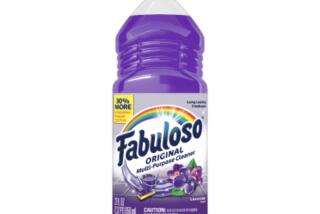Scope maker warned Europe about contamination 2 years before L.A. infections
- Share via
Nearly two years before superbug outbreaks hit UCLA and Cedars-Sinai medical centers, the maker of the scopes involved was already warning hospitals in Europe about the risk of such patient infections.
But no alerts were sounded in the U.S. by Olympus Corp., the leading manufacturer of gastrointestinal scopes worldwide, until this year. They came only after news broke in February about the UCLA outbreak, in which seven patients were sickened, including two who died.
The time lag is raising more questions about what the device maker knew about the health risk its hard-to-clean scopes posed to patients and why U.S. hospitals weren’t notified immediately.
The Japanese company and federal regulators have been criticized for not acting sooner in response to previous outbreaks.
Rep. Ted Lieu (D-Los Angeles) said this new information underscores the need for congressional hearings.
“With every passing week, more information is coming out showing that the manufacturer and regulators had a lot of information about risks of superbug outbreaks from these scopes, and nothing much happened until press stories started coming out,” Lieu said.
“That is not how device makers should run their business. It’s clear Olympus knew something was not correct about its existing cleaning instructions,” he added.
The first of two European alerts came in January 2013.
Olympus issued “important safety advice” to European hospitals and recommended a specific cleaning brush to help prevent contamination on its TJF-Q180V duodenoscope. That’s the same model at the center of subsequent outbreaks at hospitals in Los Angeles, Seattle and other cities.
Olympus sent a second safety alert in Europe in August 2014 after receiving complaints of debris on scopes even after they were disinfected.
In that letter, the company said it “is always very concerned about patient safety issues including the prevention of cross infection among patients through endoscopy.”
Olympus considered the letter so important that it asked the European hospitals to fill out and return a form acknowledging they had shared it with relevant staff.
Both notices in Europe were posted on the websites of regulatory agencies in Germany, Ireland and other countries.
Olympus didn’t respond to repeated requests for comment about the notices in Europe and the later alert in the U.S.
The company didn’t issue a similar warning in the U.S. until Feb. 19 — the day after The Times reported that 179 UCLA patients may have been exposed to the deadly CRE bacteria from Olympus scopes.
Last month, Olympus published new cleaning procedures for U.S hospitals and advised them to use the same brush highlighted in Europe, labeled as MAJ-1888.
The Food and Drug Administration said it learned of the European letters last summer but took no action then to alert hospitals.
A spokeswoman said the agency didn’t immediately take those steps because officials were already working with Olympus and two other scope manufacturers to ensure their cleaning protocols worked.
In October 2014, Olympus sent proposed cleaning instructions to the FDA, along with test data showing their effectiveness.
But the agency was concerned the instructions didn’t provide “an adequate safety margin,” said spokeswoman Jennifer Corbett Dooren, adding that the agency asked the company for more data.
Olympus submitted more test results and the FDA determined the guidelines resulted in “consistent and reliable cleaning and high-level disinfection,” Dooren said. As a result, the revised instructions, recommending the brush and other steps, were announced March 26.
About 500,000 patients nationally undergo ERCP procedures each year. Olympus is the largest supplier of duodenoscopes, with an estimated market share of 70%.
In ERCP, or endoscopic retrograde cholangiopancreatography, doctors thread the long, thin scopes down a patient’s throat to diagnose and treat cancers, gallstones and other digestive diseases.
Both letters sent by Olympus in Europe focused on trouble with cleaning the forceps elevator at the tip of the duodenoscope. That area allows for attachments such as catheters or guide wires that doctors can use.
The FDA has warned that dangerous bacteria can build up in tiny crevices in that elevator area.
Several UCLA patients and their families are suing Olympus in state court, accusing the company of negligence and fraud in selling and promoting a defective scope.
The company has said it won’t comment on pending litigation.
Seven patients at UCLA and four at Cedars-Sinai were sickened with CRE, which stands for carbapenem-resistant Enterobacteriaceae. It’s highly resistant to antibiotics and can kill up to 50% of infected patients.
Twitter: @chadterhune
Twitter: @melodypetersen
More to Read
Inside the business of entertainment
The Wide Shot brings you news, analysis and insights on everything from streaming wars to production — and what it all means for the future.
You may occasionally receive promotional content from the Los Angeles Times.











